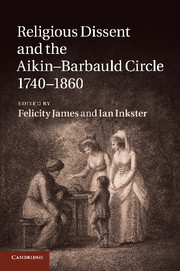Book contents
- Frontmatter
- Contents
- Notes on the editors and contributors
- Foreword
- Acknowledgements
- Chapter 1 Religious Dissent and the Aikin–Barbauld circle, 1740–1860
- Chapter 2 The Revd John Aikin senior
- Chapter 3 How Dissent made Anna Letitia Barbauld, and what she made of Dissent
- Chapter 4 ‘And make thine own Apollo doubly thine’
- Chapter 5 ‘Outline maps of knowledge’
- Chapter 6 ‘Under the eye of the public’
- Chapter 7 ‘The different genius of woman’
- Chapter 8 Lucy Aikin and the legacies of Dissent
- Chapter 9 The Aikin family, retrospectively
- Bibliography
- Index
- References
Chapter 9 - The Aikin family, retrospectively
Published online by Cambridge University Press: 05 November 2011
- Frontmatter
- Contents
- Notes on the editors and contributors
- Foreword
- Acknowledgements
- Chapter 1 Religious Dissent and the Aikin–Barbauld circle, 1740–1860
- Chapter 2 The Revd John Aikin senior
- Chapter 3 How Dissent made Anna Letitia Barbauld, and what she made of Dissent
- Chapter 4 ‘And make thine own Apollo doubly thine’
- Chapter 5 ‘Outline maps of knowledge’
- Chapter 6 ‘Under the eye of the public’
- Chapter 7 ‘The different genius of woman’
- Chapter 8 Lucy Aikin and the legacies of Dissent
- Chapter 9 The Aikin family, retrospectively
- Bibliography
- Index
- References
Summary
I
The chapters in this volume describe and evaluate many of the contributions that the Aikin family made to and through religious, intellectual, literary and political practices in the eighteenth and into the nineteenth centuries. The report from the conference where many earlier versions of these essays were presented, ‘The Dissenting Mind: The Aikin Circle, c. 1760s to c. 1860s’, opens by remarking on how many of ‘that remarkably gifted provincial family of dissenters’, the Aikins, are given entries in the New Oxford Dictionary of National Biography. Many of the New ODNB entries are by contemporary scholars, including Barbara Brandon Schnorrenberg, a distinguished women’s historian, and William McCarthy, Anna Barbauld’s biographer. Over the last twenty years researchers working on the Aikin family have produced a successful example of network study, one of the most interesting methods for looking at the cultural life of beliefs, ideas and texts that are written by and circulate among a group of people – a contemporary method that blends Namierism, women’s history and contextual study.
It is worth pointing out that these same Aikins had entries in the Old DNB as well as the New – which might be used as evidence of their importance throughout the nineteenth century. But in Leslie Stephen’s 1885 DNB, the sources for that evidence derive almost entirely from the series of memoirs of the family written by Lucy Aikin, daughter of John Aikin, ‘physician and author’, sister of Arthur Aikin, ‘chemist and scientific writer’, and Charles Rochemont Aikin, ‘doctor and chemist’, and niece of Anna Barbauld, ‘poet and miscellaneous writer’, and all the articles are signed A. A. B., Arthur Aikin Brodribb. The obituary in The Times for Brodribb, which praises his long service to that newspaper as a gallery reporter at parliament, reminds the reader that, ‘[h]is grandmother, Susan Aikin, was a granddaughter of John Aikin, M. D., a well-known writer in his day and the brother of Mrs. Barbauld’ (who, this sentence implies, remains well known). Coteries require their own historians if they are to be known coteries, and if the Arthur Aikin Brodribb articles suggest that the Aikins wrote themselves into the DNB, it has been literary critics and historians of women and literature written by women, who have created our current interest in Anna Barbauld and her family. The most recent instance is William McCarthy’s summation of twenty years of research in his authoritative biography of Anna Barbauld, a discussion that combines feminist sympathy with attention to the range and power of Anna Barbauld as an Enlightenment poet. Taken altogether the Aikin-related entries in the Old and NewDNB, along with more detailed twentieth- and twenty-first-century studies, agree that the importance of their network of family and friends lies in their rootedness in the late eighteenth-century religious culture of heterodox, Rational Dissent, and their attachment, both intellectually and as an idealized geography, to the Warrington Academy, founded in 1757. One result of network studies has been that we can make the case that the Aikins’ subsequent contributions to broader institutions of learning, literary and liberal practice reached a wider public than their marginal social and religious place (marginal even within Dissent) might have predicted.
- Type
- Chapter
- Information
- Religious Dissent and the Aikin-Barbauld Circle, 1740–1860 , pp. 205 - 229Publisher: Cambridge University PressPrint publication year: 2011



